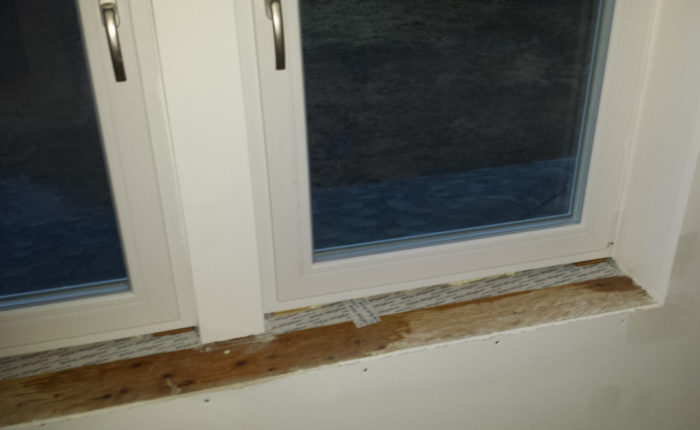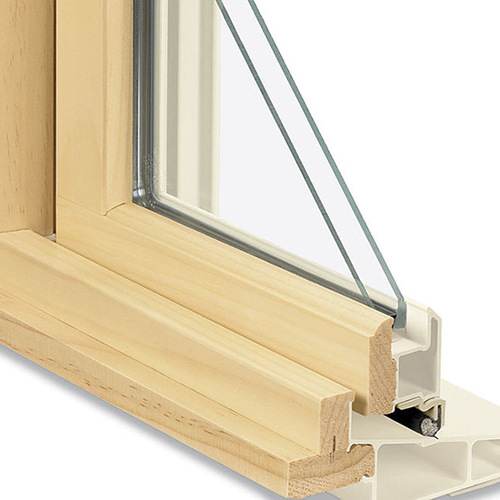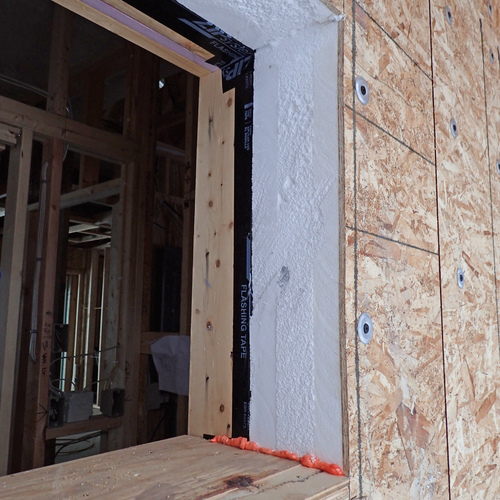
Image Credit: Brian Beaulieu
Brian Beaulieu would seem to be well on his way to enjoying a high-performance house in southern Maine. The double-stud walls are 10 1/2 inches thick and insulated with mineral wool. The exterior air barrier is the taped Zipwall system, backed up with airtight drywall on the interior for a second line of defense against air leakage.
Beaulieu has invested in top-quality tripled-glazed Intus windows suitable for Passivhaus designs. And it’s here that Beaulieu has run into a problem.
“We’ve made a few errors which are now rearing their ugly head,” he writes in a Q&A post at GreenBuildingAdvisor.
Plywood shims on which the window sits are exposed on the inside, forming (in Beaulieu’s words) “a perfect thermal bridge.” The shims and now the rough window sills themselves are getting wet, apparently from condensation.
And weep holes on the exterior of the frames were accidentally blocked with tape and trim, causing water to build up in the frames. The weep holes have since been uncovered, and Beaulieu plans on drying out the sills and shims with a heat and a fan.
“We seem to have found the root of our condensation issues,” he writes. “Or have we? If not, what else am I missing?”
His window problems are the start of this Q&A Spotlight.
The house will dry out in time
Beaulieu’s house is showing typical signs of high humidity in new construction, GBA Senior Editor Martin Holladay writes. “Your house is humid because of construction moisture from the concrete foundation and drywall mud,” he says. “After 6 or 12 months, everything will dry out and stabilize.”
He adds that it would be cheaper for Beaulieu to turn on a bathroom exhaust fan and let it run 24 hours a day than it would to use…
Weekly Newsletter
Get building science and energy efficiency advice, plus special offers, in your inbox.

This article is only available to GBA Prime Members
Sign up for a free trial and get instant access to this article as well as GBA’s complete library of premium articles and construction details.
Start Free TrialAlready a member? Log in















5 Comments
Window flashing
I have been a remodeling contractor in South East Wisconsin for almost thirty years. My business is Aaron's Building Services. This looks like a flashing issue and not a new construction moisture issue. Martin and Peter hit it on the head. There needs to be a sloped or dammed sill pan, the pan needs to extend past the WRB. This talk about advancements in window technology is interesting. Before the last 1/3rd of the 20th century, windows had built in sloped sills. Manufactures have moved away from this. As Peter has pointed out, the lack of integrated flashing from window manufactures. The windows need to be removed and re flashed. Do not use picture frame trim at the bottom of exterior of the window. And lastly. Is there any head flashing? If water comes in at the head of the window you already have a issue.
Seals, vents and drains
Water has a long lists of states of being. It falls, runs, drips and pools. Water also condenses, evaporates, it's in vapor and it freezes. Plastic, vinyl, glass and wood all move.
Deciding where and when things will move and which states water will be and when in assemblies that sit out in the sun, wind and rain and contain warm moist air to keep us happy isn't always as simple as it looks.
I'm wondering if the windows have flashing over the flanges or under. Where are the seals, vents and drains around the window so the assembly can move and keep everyone happy for a long time?
Horizontal surfaces need drains so gravity will prevent water from pooling. Horizontal surfaces also need seals - with drains being the first place for water to go next.
Since water condenses and it evaporates and it floats in the air as humidity it needs a vent.
Is the envelope a barrier or a rainscreen? When the wall heats up where will the air escape? When it cools how will the condensation drain and dry?
When it rains where does the water on the glass go? When I watch windows in the pouring rain the water mostly finds the bottom corners. Picture frame joinery is a good way to get water behind the trim. It looks like the weep hole covering trim has a reverse lap bonus at the bottom - the trim on the vinyl extrusion creates a pool where you need a drain.
My vote is with Aaron's assessment. Pull the window out and use a rainscreen barrier system and get the trim behind the outer drainage plane of the window. Maybe you could have a custom sloped sill pan made out of copper - why not go all out? Or try it this way: http://www.vaproshield.com/images/stories/pdf/liquiflash_install_instruct_082713.pdf
Condensing Surface Within the Frame Assembly itself?
Looking at the interior photo and where the water is pooling, it appears most of the wetting is happening at the mull between the two window units (most of it here) and along the outer frame. I'm assuming this is a factory mulled window unit and not a stud pocket built in the field? Follow the water marks on the rough sill. Looks pretty dry directly below the glass so seemingly the interior glass surface is staying warmer than the frame/mull? Or perhaps that’s where the sun has dried out the rough sill before the photo was taken? Is the builder seeing excess condensation on the glass itself in the mornings? Is it possible that there's a piece of structural aluminum or steel vertically within that mull and its surface temp is lower than the glass and thus is the condensing surface for the construction humidity? It's hard to eliminate thermal bridging in this application. If that's where the moisture is condensing, I'd expect that will always be the weak spot in the thermal envelope for this home unless someone pokes a new hole somewhere else. Are the wet sills showing up more on mulled units than singles and does the pattern tend to indicate the moisture is running out from the mull itself rather than off the glass? Last I checked, even with the highest quality windows, the frames are still the weakest link in their overall performance and drag the performance of the glass down. Is there any possibility of adding insulation to that mull post before you cover it all up with finish trim? Would you expect in the future that whenever this homes humidity increases water is going to condensate in these same locations? It doesn't seem like having excessive condensation WITHIN the window frame itself is the most durable assembly long term.
A new years salute to the importance of mechanical ventilation!
More info
Not exactly how I want to see my name in print but I suppose it could be worse...
I think the first attached photo is a bit misleading. After an intense driving rain late last fall, the inner channel within the window frame backed up into the house as they had no where to drain to prior to opening the weep holes up. This was the cause of this particular water stain. Although we should have used a sloped sill or backdam approach in our window installations, I do not believe bulk water is making its way past our flashing. I've attached a photo of the flashed windows prior to siding. The Wigluv tape went on quite smooth without bubbles or folds and once it was on, there was no getting it off, it made Ziptape look like painters tape. We did not use flanges, we flashed the window frames to the face of the zipwall. Additionally, we did install head flashing over each window.
To answer Russ' question, the mullion in the photo was a field built 2x4 box with a 2" XPS insulation core, it does not appear to be showing signs of condensation.
We have not noticed any issues since opening the weep holes and installing our HRV. Things have dried out sufficiently. We plan to leave the interior window stools off until spring to allow further drying. We also intend to remove the trim in the spring to see if there is anything alarming behind there. The next driving rain will be the big test but its going to just be the white fluffy stuff around here for a few more months.
Year Follow-Up
Brian,
It's been over a year since this article. What did you conclude? I would be curious to hear if it was the flashing or something else that caused the water issue.
Log in or become a member to post a comment.
Sign up Log in